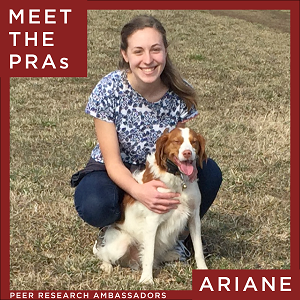Meet Ariane Garrett ’20 (ENG, CLAS), an OUR Peer Research Ambassador (PRA) majoring in Biomedical Engineering and Spanish.

What is the focus of your research/creative activity?
I work in the Hoshino Laboratories developing a novel cerebral spinal fluid shunt capable of detecting flow. Cerebral spinal fluid shunts are the primary form of treatment for hydrocephalus, a disease that causes a buildup of cerebral spinal fluid (CSF) in the brain. Shunts are intended to be lifelong implants but are very prone to failure. In addition, the symptoms of shunt failure are often ambiguous, making it difficult to diagnose. Our device aims to solve this problem by creating a simple, cost effective, and non-invasive way of determining CSF flow through the shunt.
Why did you get involved in research/creative activity?
I initially got involved in research because I was curious about the research process and I wanted to learn more about biomedical engineering. I stayed involved with research because I really enjoy the design process, and it is extremely rewarding to see your ideas come to life. At this point, I’ve been working on my project for over a year now. Throughout this time, I’ve grown as a researcher and learned many useful skills that I wouldn’t have in the classroom.
What advice would you give to incoming freshmen?
When you first join a lab, it may seem very boring or overwhelming. Try to stick with it for a little while and be patient. Most likely, it will take time for you to be given real responsibility and interesting tasks. In the meantime, learn as much as you can by observing those around you and reading relevant literature.
What do you enjoy the most about participating in research/creative activity?
As an engineer, my favorite part of research is the design process. You start with a conceptual goal and a few parameters that must be met, and it’s your job as the researcher to turn that concept into reality. I always start by brainstorming and sketching in my lab notebook. Then, after I’ve fleshed out my idea a bit more, I design it in Solidworks. At this point I seek feedback from other people in the lab, who often point out some problems I missed the first time. Then, I make a procedure for turning the design into reality. Sometimes, that just involves sending the design to Shapeways, other times it requires designing and milling molds. Finally, the design is made. It’s pretty cool to hold a part you designed in your hands, knowing every little detail that went into its creation.
What is your greatest accomplishment so far?
My greatest research accomplishment so far was presenting at the Holster Scholar symposium early in my sophomore year. After spending the whole summer working on my project and struggling to find my place in the lab, it was rewarding to stand up in front of my peers and talk about my accomplishments. Even though that time didn’t mark the height of my research achievements, it signified the end of my first summer doing research full time, living in an apartment, and working independently. I proved to myself that I was capable of seeing my project through to the end, and it felt great!